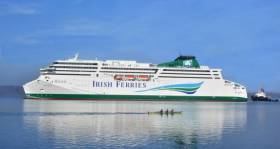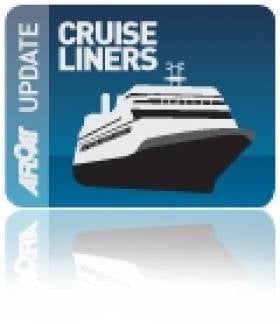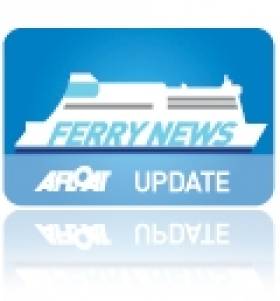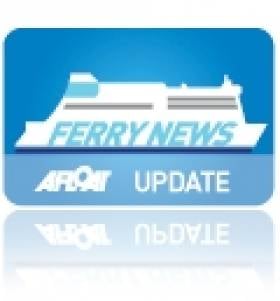Displaying items by tag: Cruiseferry
Irish Ferries is pleased to announce the addition of a new cruise ferry to its fleet with the introduction of the ship to be renamed Oscar Wilde.
Originally the cruiseferry called the Star served in the Baltic Sea and was built in 2007 in Finland for the Tallink Grupp, Afloat adds an Estonian shipping company.
The Oscar Wilde will be the largest and fastest passenger cruise ferry on the Irish Sea with an impressive capacity of over 2,080 passengers, 134 cabins, and ample space with over 2,380 lane meters for cars, coaches, and freight vehicles.
With the largest duty-free shopping space for any cruise ferry on the Irish Sea of more than 17,000 square feet, it will be an ideal shopping destination for those travelling between Ireland and Britain.
The ship interiors have a classic, modern feel and boasts Freight Drivers facilities, Club Class lounge, a self-service restaurant, an à la carte restaurant, a bar, gaming facilities, pet facilities and family-friendly features such as a children's play area.
One of the most exciting features of the Oscar Wilde is its available speed. With a possible top speed of 27.5 knots, it is the fastest cruise ferry with the largest passenger capacity on the Irish Sea.
This will enable Irish Ferries to offer tourism passengers and freight an efficient service, getting them to their destination reliably and comfortably.
Commenting on the new addition, Irish Ferries Managing Director, Andrew Sheen, said, "We are delighted to announce the addition of the Oscar Wilde to our fleet. This new ship will be a fantastic addition to our service, offering customers the very best in terms of comfort, speed, and amenities.
Along with usual advantages of ferry travel in terms of no luggage restrictions or security queues, we are confident that the Oscar Wilde will become a firm favourite with our passengers and freight drivers, and we look forward to welcoming them on board."
The Oscar Wilde will initially enter service on the Rosslare-Pembroke route in early June, replacing the chartered Blue Star 1 for the busy summer period.
With its impressive size, speed, and range of facilities, it is set to become the ultimate choice for those travelling between Ireland and the UK on the southern corridor between Wales and Ireland.
Cruiseferry WB Yeats Set to Dock in Dublin Port Following Cancellations
#ferry -Cruiseferry WB Yeats, which was originally scheduled to begin Dublin-France operations almost five months ago, is expected to dock in the capital next week, Irish Ferries has said.
As The Irish Times writes, the shipping company cancelled 6,000 bookings on the ferry in August and September, with the travel plans of at least 19,000 people affected.
This followed the cancellation of all bookings on the WB Yeats for more than two weeks in July, which affected about 10,000 people.
The company blamed “extraordinary circumstances beyond its control”.
The delivery of the €147 million vessel had been delayed by German shipbuilder FSG which, in a statement, attributed the delay to receiving parts late from suppliers.
For further reading click here and previous Afloat coverage prior to first sea-trials.
Cruiseship Berths at Cork Harbour’s Ferryport Terminal
#CruiseFerryBerths - Brilliance of the Seas departed Cobh in the afternoon followed by Discovery this evening, the latter notably had berthed at Ringaskiddy Ferry Terminal as distinct to docking at the adjacent deep water berth, writes Jehan Ashmore.
The Royal Caribbean Lines 90,000 tonnes 'Radiance' class Brilliance of the Seas had called to Cobh's dedicated 'cruise' terminal before she headed for Klasvik, Norway. As for Discovery she is bound for St. Mary's, the capital of the Scilly Islands.
Normally, when more than one cruise caller arrives the same day, the Ringaskiddy deepwater berth that mostly accommodates large ocean-going cargoships also caters for cruiseships that has included the famous 'Cunarder' QE2.
Discovery of 19,900 tonnes is on charter to Cruise & Maritime Voyages, she had berthed at the Ringaskiddy Ferry Terminal ro-ro berth jetty. It is at this berth that Brittany Ferries cruiseferry, Pont-Aven of 41,700 tonnes, making her twice the size of the cruiseship, calls from Roscoff on Saturdays. She has a capacity for 2,400 passengers and like cruiseships, she features a pool.
The intimate 700 passenger Discovery is a small vessel in today's cruiseship market. She was launched as Island Venture in 1971 and is the surviving sister of a pair of almost 20,000 tonnes vessels built for Norwegian based Flagship Cruises.
The German built sisters were better known during careers for Princess Cruises as the Island Princess and Pacific Princess, which saw them appear in the popular US TV series the 'Love Boat' during the 1970's. The latter sister was scrapped this year.
On completion of this current cruise, Discovery departs Bristol (Avonmouth) on a 14-night cruise to the Azores and Madeira. It is understood that following her final cruise for CMV in October she is due to be sold.
Overnight Sailing Marks End-of-Seasonal French Route
The former Scandinavian cruiserferry was built in 1987 to serve on Color Line's Oslo-Kiel route as their Kronprins Harald. In 2007 she was sold to start French sailings and at 31,914grt, she is the largest cruiseferry to operate under Irish Ferries continental routes. Passenger capacity is just shy of 1,500 and cars total 730 in addiition space for around 90 freight vehicles. For a virtual tour of the cruiseferry's on board facilities and exterior deck views click HERE.
Winter sailings will run to the end of the year with a final departure on 30th December outbound and returning from France on 2nd January 2012. Thereafter there will be a no sailings as the cruiseferry is to undergo annual dry-docking before resuming sailings. The first sailing from Ireland is 19th February and the corresponding return sailing from France is 21st February. To keep up-to-date with sailing schedules click HERE.
Irish Sea Cross Channel Fast-Ferry Services On Declining Trend
The third service between Belfast-Stranraer is in the hands of rivals Stena Line which maintain the HSS Stena Voyager (1996/19,638 grt) on sailings but only to around mid-November. She will be replaced by conventional sister-ships which will be introduced on the North Channel's newest port when services switch from Stranraer to a new terminal close to Cairnryan.
Finally the fourth fast-ferry is Irish Ferries marketed 'Dublin Swift' service which runs on the Dublin-Holyhead route served by Jonathan Swift (1999/5,989 grt). The craft built by Austal in Fremantle, operates alongside the conventional cruise-ferry Ulysses.
Stena Line's decision to terminate HSS Stena Explorer sailings between Dun Laoghaire-Holyhead this day last week follows fast-ferry Stena Lynx III's end-of-season Rosslare-Fishguard sailings earlier this month.
From next year, Dun Laoghaire-Holyhead sailings are to be seasonal-only and according to Stena Line they hope to resume fast-ferry sailings in April or May though no exact date has been set. Unlike the central corridor route which was entirely dependent on HSS operations, the Rosslare-Fishguard route remains operating year-round with the conventional ferry Stena Europe.
As a result of the discontinued fast-ferries, the HSS Stena Explorer is now spending a lay-up period in the Welsh port for the winter. The smaller Stena Lynx III is also 'wintering' but in on the opposite side of the Irish Sea in Dun Laoghaire, where the vessel has done so in previous years.
The lay-up of both fast-ferries in Dun Laoghaire and Holyhead is ironic considering that neither ports' are connected by the very craft that used to share sailing rosters in recent years. In addition the wintering of these catamaran craft is the first time that this has occurred since the pioneering Stena Sea Lynx fast-ferry launched such sailings in 1993.
This first 'Lynx' provided seasonal sailings on the route with conventional car-ferry Stena Hibernia, the former St. Columba, custom-built in 1977 for Sealink /British Rail. She was given a second name under Stena ownership, the Stena Adventurer and remained on the 57 nautical-mile route until replaced in 1996 by the year-round operated HSS Stena Explorer.
Apart from cross-channel fast-ferry services, the Isle of Man is served by the Isle of Man Steam Packet Co. Ltd's routes linking the islands capital Douglas with Belfast, Dublin, Heysham and Liverpool (Birkenhead) in the winter. These routes include seasonal services which are operated by a combination of conventional tonnage using Ben-My-Chree and fast-ferry Manannan (1998/5,089grt), a former US Navy vessel, to read more click HERE. For sailing schedules, vessel type deployed on route and for fares click HERE.
- Dublin Port
- Irish Ferries
- Dun Laoghaire
- Stena Europe
- Holyhead
- P&O Ferries
- Belfast Harbour
- Stena Line
- Larne
- Ports and Shipping News
- Ulysses
- P&O (Irish Sea)
- Cairnryan
- Ferry news
- Stena Explorer
- Stena Express
- FastFerries
- Cruiseferry
- Manannan
- Isle of Man Steam Packet Co.
- Stena Voyager
- Belast Port
- Isle of Man ferry services
- P&O Express
- Irish Sea fastferries
- Stena 'Lynx'
- BenMyChree
- Dublin Swift
- Stena Sea Lynx
Seasonal Services Set Sail ‘Four’ France
Also operating on the same route to Normandy are Celtic Link Ferries which run the modern sleek Italian built 800 passenger /200 vehicle ro-pax ferry Norman Voyager. Short wine breaks are from €200 return for a car, driver and a two-berth outside cabin. Additional passengers can travel for €10 each way and subject to sailing schedules passengers can stay in Cherbourg for up to five hours.
A third operator to France is Brittany Ferries which sails on the Cork-Roscoff route and which is served by their 'flagship' Pont-Aven. The €100m ferry has a swimming pool and this is unique to any route operating out of Ireland. The company are offering one-way fares from €70 per person based on a car with four adults in an inside cabin.
Sailings depart Saturday's from Cork and arrive in the Breton port 14 hours later, making the route the shortest and fastest of the four continental services.
Ulysses Celebrates 10 Years of Irish Sea Service
In January 2000 the keel of the worlds largest car ferry was laid at the Aker Finnyards in Rauma, Finland. The following year the €100m cruiseferry giant departed the shipyard on a four-day delivery voyage to Dublin Port. Upon Ulysses's arrival on 4th March she was presented with a traditional welcoming escort of saluting water-firing tugs.
The Ulysses was named at a ceremony in the port on 21st March by the 'golden godmother' Mairead Berry, Ireland's 25-year old Paralympic Games gold medallist. Four days later Ulysses made her commercial maiden voyage to Holyhead on 25th March.
Wih 12 decks the vessel has an extensive range of facilities and they are named with themes derived from James Joyce's famous novel 'Ulysses'. There is seating available for up to 1,938 passengers and there are 117 twin or single-cabins, accommodating up to 228 passengers.
Only two months into service the Ulysses won the prestigious 'Most Significant New Build - Ferry' category award in the Cruise & Ferry magazine 2001 Awards competition. Her Finnish builders are not only builders of large cruise-ferries for Baltic Sea operators and beyond but also are also renowned for the construction of very large cruiseships for international clients.
Ulysses was designed specifically to serve the central corridor route with a schedule of two round trips daily. She directly replaced the 1997 Dutch built 34,031 grt ro-pax Isle of Inishmore, which transferred to Rosslare-Pembroke Dock service.
In 2006 the Ulysses alongside her fleetmates were transferred from the Irish flag to the Cypriot flag in addition to a change of Irish crew with those outsourced from citizens mostly from the Baltic and Eastern European countries.
Due to the sheer size of the Ulysses, which has a length of 209m, a beam of nearly 32m and a 6.4m draught, she has not missed a single crossing due to bad weather conditions. The vessel has a 22 knot / 41kph service -speed on the 60-mile route which translates to a distance of over 182,000 kms a year.
To celebrate Ulysses 10th year in service, Irish Ferries has enhanced the Club Class option to passengers which includes free-Wifi, which enables a constant connection and an array of other benefits during the 3-hour 15 minute crossing.
For a virtual tour of the Ulysses with views taken from the top deck as the cruiseferry departs Holyhead and the mountains of Snowdonia setting as a backdrop plus interior tours of the vessel click here.


































































